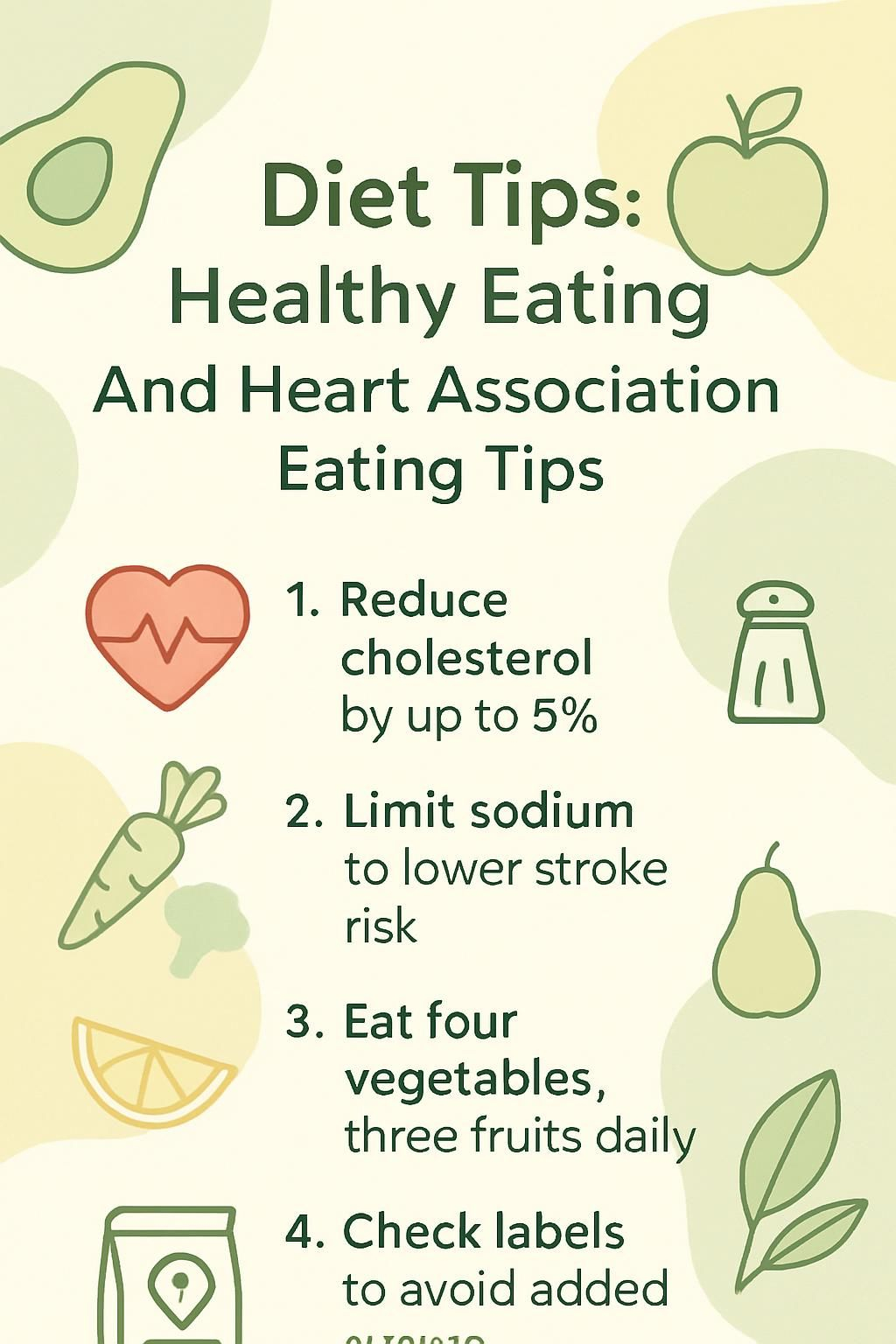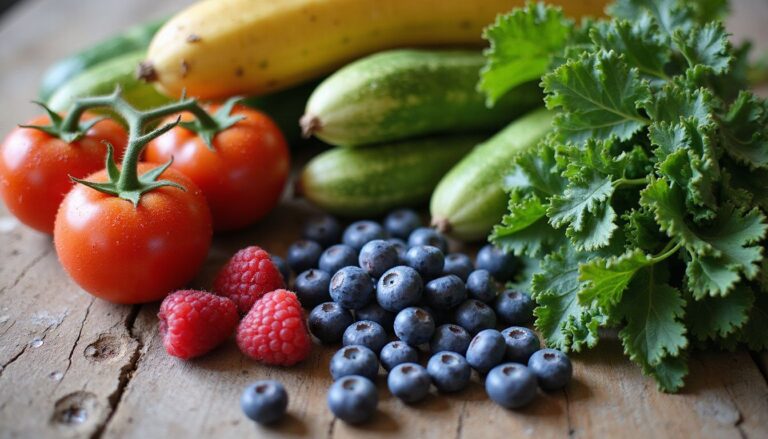Diet Tips: Healthy Eating And Heart Association Eating Tips
Our Nutrition Assistant AI Suite will transform your body. You will lose fat, get toned, and build muscle. Gain confidence and optimal health.
You may want to eat healthier but feel unsure where to start. Healthy eating lowers your risk of heart disease, obesity, high blood pressure, and type 2 diabetes. A healthy diet gives you steady energy, better focus, and long-term protection.
This guide turns broad advice into simple steps you can use today. You will find clear Diet Tips and practical eating tips from the American Heart Association that fit home, school, and work.
Key Takeaways
- Healthy eating helps prevent heart disease, obesity, high blood pressure, and type 2 diabetes, as outlined by the American Heart Association (AHA).
- Swap saturated fat for plant oils and choose whole grains daily. These changes may reduce LDL cholesterol and lower cardiovascular risk by about 5% (AHA Diet Recommendations 2023).
- Over 70% of the sodium in the U.S. diet comes from processed foods. Cutting sodium reduces the risk of stroke and heart attack (CDC, 2022).
- Aim for at least four servings of vegetables and three servings of fruit each day to boost fiber, vitamin D, calcium, and potassium.
- Reading food labels helps you manage added sugar and portion sizes. Many packages contain more than one serving per container.

Why Is Healthy Eating Important for Your Body?

A healthy diet supplies vitamins, minerals, and other nutrients your body needs for growth and energy. Choosing foods low in saturated fat and added sugar can lower cholesterol and reduce the risk of heart disease or type 2 diabetes.
United States Department of Agriculture surveys show many Americans fall short on dietary fiber, calcium, vitamin D, and potassium. These nutrients support strong bones, regular digestion, stable blood pressure, and heart health.
Too much sodium raises blood pressure. Higher blood pressure, also called hypertension, increases stroke and heart attack risk. A quick example: I tracked my meals for a month after a high cholesterol reading. Switching from white bread to whole grain bread kept me fuller and more energetic.
Good nutrition is a foundation for health at every stage of life.
Eating well also supports physical activity since proper nutrition helps you recover after workouts.
Core Principles of a Balanced Diet
A balanced diet covers your nutrient needs and supports a healthy weight. Small, steady changes create lasting progress.
How Can You Include a Variety of Food Groups?
Mixing food groups gives you a broad range of nutrients. Use these steps to build balance into each meal.
- Fill half your plate with colorful fruits and vegetables to increase vitamins, minerals, and fiber.
- Choose whole grains like brown rice, barley, oats, or whole wheat pasta instead of white rice or white bread.
- Include protein sources such as seafood, lean meats, skinless poultry, eggs, beans, lentils, soy foods, nuts, and seeds.
- Pick fat-free or low-fat dairy products or fortified soy beverages for calcium and vitamin D.
- Cook with vegetable oils, such as olive or avocado oil, instead of butter or partially hydrogenated oils.
- Limit ultra-processed foods high in sodium, added sugars, trans fat, or saturated fat.
- Choose plant-based proteins like beans, lentils, or tofu several times a week to lower saturated fat.
- Drink water or unsweetened beverages instead of sugary soft drinks.
- Compare Nutrition Facts labels. Choose items lower in saturated fat and added sugar, and higher in fiber.
- Rotate your vegetables, fruits, proteins, and grains so no single food dominates your meals.
- Aim for at least four servings of vegetables and three servings of fruit each day, as the AHA suggests.
What Are Effective Ways to Control Portion Sizes?
Right-size portions help you maintain a healthy weight and avoid eating too much. These tips keep servings in check without guesswork.
- Use smaller plates and bowls to make proper portions look satisfying.
- Measure foods with cups or a kitchen scale, especially calorie-dense items like nuts, cheese, or full-fat dairy.
- Fill half your plate with fruits and vegetables to lower calories and raise nutrient intake.
- Plan meals before eating out. At home, decide portions during prep to reduce overeating.
- Pack snacks like yogurt or nuts in small containers to limit calories.
- Check serving sizes on labels. Many packages contain two or more servings.
- Eat slowly and wait 10 to 15 minutes before taking seconds.
- Pick single-serve snacks instead of eating from large bags.
- Set small action goals, such as portioning fries before eating, to build steady habits.
A quick example: once I measured my breakfast cereal, I saw I ate double the serving. Adjusting the portion helped me meet my daily goals.
Why Should You Minimize Processed and Sugary Foods?
Processed foods supply most of the sodium in the American diet. Many also pack unhealthy fats and added sugars, which raise the risk for cardiovascular disease and some cancers.
Sugary drinks, desserts, and fast food add extra calories that drive weight gain. Cutting back on these items helps reduce cholesterol and supports a heart-healthy eating pattern. I swapped my daily soda for fruit-infused water and felt more energetic within weeks.
Choosing whole foods improves your mineral and vitamin intake from natural sources.
Make healthy choices by reading food labels carefully before you buy packaged items.
American Heart Association Eating Tips
The American Heart Association recommends a simple pattern: more plants, more whole foods, and fewer highly processed choices.
How Can You Focus on Fruits and Vegetables?
Produce adds fiber and protective nutrients to every meal. Use these easy swaps to raise your intake.
- Fill half your plate with fruits and vegetables at meals, a core idea in the DASH eating plan.
- Snack on raw vegetables like carrots, bell peppers, or celery instead of salty or fried foods.
- Choose fresh fruit for dessert to cut added sugar and support lower cholesterol over time.
- Add vegetables like broccoli, peppers, or onions to omelets, stews, and sauces.
- Season with herbs and spices, such as basil or oregano, instead of high-sodium dressings.
- Try plant-based choices, like fortified plant milk or soybeans, to diversify nutrients.
- If you make veggie juices, skip added honey or sugar to keep calories in line.
- Shop seasonal produce at markets for peak flavor and nutrients.
- If you need ideas, talk with a dietitian about ways to fit more plant foods into snacks and meals.
Why Choose Whole Grains Over Refined Grains?
After increasing fruits and vegetables, focus on whole grains. Whole grains, such as brown rice and whole wheat bread, deliver more fiber, vitamins, and minerals than refined grains.
Replace white rice or pasta with quinoa or bulgur. Oatmeal is another high-fiber option that supports steady energy.
Fiber helps digestion, keeps you full longer, and supports heart health. Since most people do not get enough fiber, adding whole grains at each meal is a simple win.
What Are Healthy Lean Protein Options?
Choose lean and plant-forward proteins to support heart health. Include seafood, lean cuts of poultry, eggs, beans, lentils, tofu, tempeh, nuts, and seeds across the week. The AHA suggests eating fish, such as salmon or trout, at least twice per week for omega-3 fats.
Prioritize beans and lentils over fatty meats to lower saturated fat. Try adding beans to tacos or salads for fullness and fiber. I switched ground beef for black beans in tacos last year, and I stayed full longer with less fat.
Nutritional Comparison Table:
| Protein Source | Fat (g per 3 oz) | Protein (g per 3 oz) |
|---|---|---|
| Skinless Chicken | 3 | 25 |
| Salmon | 5 | 22 |
| Black Beans | <1 | 8 |
| Tofu | 4 | 9 |
Swap some red meat for these options to cut saturated fat linked with higher heart disease risk. Variety keeps meals interesting and improves your overall nutrient intake.
How Can You Limit Saturated and Trans Fats?
Use plant oils, such as olive, canola, sunflower, safflower, peanut, or soybean oil, in place of butter or cream. Choose low-fat yogurt or avocado for creamy spreads and smoothies.
Pick fat-free dairy products and lean meats. Beans and seafood are protein choices that keep saturated fat low. A small change, like mashed avocado on toast instead of cheese spread, can feel just as rich with less saturated fat.
These swaps lower LDL cholesterol and reduce heart disease risk over time.
How Do You Reduce Added Sugars and Sodium?
Drink water instead of sugary beverages. Add lemon, berries, or cucumber slices for flavor. Check labels and choose products with little or no added sugars and lower sodium.
Many snacks, sauces, and ready meals hide extra salt and sugar. Skip flavored coffee syrups, whipped toppings, and sugary breakfast items when possible. Cooking at home lets you control how much salt and sweetener you use.
I switched from instant flavored oatmeal to plain oats with fresh fruit. That change cut more than 10 grams of sugar per breakfast. Reducing sodium helps lower blood pressure, and limiting added sugar supports a healthy weight.
Choose whole foods and follow AHA guidance to support a heart-healthy eating pattern.
What Are Healthy Oils to Use in Cooking?
After cutting added sugars and sodium, check your cooking fats. Plant oils like canola, olive, peanut, safflower, soybean, and sunflower provide unsaturated fats that help lower LDL cholesterol.
Use these oils in dressings, roasting, or sautéing. I use extra-virgin olive oil in pasta dishes instead of butter. The taste is great, and the fat profile is healthier.
Evidence shows replacing saturated fat with unsaturated fat supports long-term heart health.
Practical Diet Tips for Everyday Life
Healthy habits stick best when they are simple and repeatable.
How Can Meal Planning Improve Your Diet?
Planning your week reduces guesswork and last-minute takeout. It also makes portions easier to manage.
- Map out meals with all food groups for balanced nutrition.
- Prep ahead so you avoid fast food high in sodium, added sugars, and saturated fat.
- Shop with a list to limit impulse buys of processed snacks.
- Decide portions during prep. Smaller portions can reduce overeating by up to 30%.
- Keep healthy snacks ready, such as fruit, nuts, or yogurt.
- Track meals to manage calories and nutrients with more accuracy.
- Schedule one new recipe that uses whole grains, lean proteins, vegetables, and plant oils.
Next, see how home cooking gives you even more control.
What Are the Benefits of Cooking at Home with Fresh Ingredients?
Cooking with fresh, minimally processed foods boosts fiber, vitamins, and minerals. You also control additives and portions.
- Choose ingredients low in saturated fat and higher in healthy unsaturated fats.
- Avoid excess sodium and added sugars common in restaurant and packaged foods. More than 70% of U.S. sodium intake comes from these sources (CDC, 2022).
- Increase fiber by adding fruits, vegetables, and whole grains. Adults need about 25 to 30 grams per day (AHA).
- Use olive or canola oil instead of hydrogenated fats that contain trans fat.
- Improve vitamin intake. Leafy greens supply potassium, and dairy or fortified foods add calcium.
- Homemade meals often have higher mineral content, such as magnesium and vitamin C.
- Control portions at home rather than letting large restaurant servings set the pace.
- Well-planned meals cover most nutrient needs, which can reduce reliance on supplements.
- A Johns Hopkins study found people who cook most nights eat fewer calories, sugar, and refined carbs.
How Do You Read and Understand Food Labels?
Labels help you choose foods and drinks that fit your goals. Use these steps in the store and at home.
- Read the Nutrition Facts label for calories, fats, sodium, added sugars, protein, and fiber per serving.
- Check serving size. Packages often contain several servings.
- Scan the ingredient list for added sugars like cane sugar, corn syrup, and fructose.
- Pick items labeled
low sodium
orno added sugar
when available. - Compare similar products side by side. Choose lower saturated fat and sodium.
- Look for heart-healthy oils, such as olive or canola, instead of butter or shortening.
- Use percent Daily Value. About 5% DV is low, and 20% DV is high for a nutrient.
Understanding labels supports portion control and a balanced diet. Next up, hydration.
Why Is Staying Hydrated Important and What Drinks Are Best?
Hydration supports every cell in your body. It helps temperature control, digestion, and circulation.
- Water is the best choice. It has zero calories and helps your body work well.
- Choose water instead of soda, fruit drinks, or energy drinks to avoid added sugar.
- For variety, try unsweetened herbal tea or plain coffee.
- Add lemon, berries, cucumber, or mint to water for flavor without sugar.
- Fluid needs vary by size, climate, and activity. Many people use eight 8-ounce glasses as a simple daily target.
- Use sports drinks only after long, intense exercise since most contain added sugar.
- Limit energy drinks. High caffeine and sugar can raise blood pressure.
- Check flavored waters for added sugars or artificial ingredients.
- Fill a reusable bottle in the morning to track your intake.
Drinking enough water helps your heart, supports focus, and prevents extra liquid calories.
Boosting Nutrient Intake
Small upgrades add up. Think of each meal as another chance to balance your plate.
How Do You Increase Fiber Intake with Whole Grains, Fruits, and Vegetables?
Fiber keeps digestion regular and supports heart health. These simple swaps raise your daily total.
- Snack on raw vegetables like carrots, celery, or bell peppers.
- Pick whole-grain cereals such as oatmeal. Add berries, seeds, or nuts.
- Use bulgur or quinoa instead of white rice or pasta.
- Stir beans or lentils into soups, salads, and stews. One cup of cooked lentils has around 15 grams of fiber.
- Choose fruits like apples, berries, pears, oranges, and bananas.
- Include leafy greens and cruciferous vegetables such as spinach, broccoli, and Brussels sprouts.
- Use whole wheat bread for sandwiches to feel fuller longer.
- Carry small packs of nuts or seeds for a quick fiber boost.
- Drink water so fiber can do its job.
Work toward 25 to 30 grams of fiber per day from food, as recommended by the AHA.
What Are Good Sources of Calcium for a Healthy Diet?
Calcium supports bones, teeth, and muscle function. Choose fat-free or low-fat dairy milk for calcium with less saturated fat. Fortified soy drinks also provide calcium and vitamin D.
Many fortified plant beverages offer about 300 milligrams of calcium per cup, which is similar to dairy milk. Canned salmon with bones or sardines add natural calcium. One small can of sardines can provide more than 300 milligrams.
Leafy greens, such as bok choy and kale, supply calcium too. Some mushrooms and root vegetables like taro contribute smaller amounts that still help your total.
Which Foods Are Rich in Potassium?
Potassium helps control blood pressure. You can get it from many foods. Beets, lima beans, and Swiss chard are top choices. Prune, pomegranate, and orange juices contain meaningful amounts per glass.
Fat-free milk and low-fat kefir, a cultured milk drink, also supply potassium. Bananas remain a simple pick you can add to breakfast. One medium banana has about 422 milligrams of potassium^1^.
These foods support heart health and fit easily into daily meals.
^1 USDA FoodData Central: Banana (medium) Potassium content
How Can You Ensure Adequate Vitamin D Intake?
Vitamin D helps your body absorb calcium and supports immune function. Many people need vitamin D from food, especially if they get little sun. Fortified milk, plant milks, orange juice, and cereals list vitamin D per serving on the label.
Check labels to compare products. Wild salmon and sardines are natural sources. Three ounces of cooked salmon may provide up to 570 IU of vitamin D. Eggs and some mushrooms contribute smaller amounts.
If you have concerns about vitamin D, ask your healthcare professional about testing and individualized advice.
Strategies for Weight Management
Healthy weight control comes from steady habits, not strict rules. Think progress, not perfection.
Why Eat Smaller, More Frequent Meals?
Smaller, frequent meals can reduce hunger and cut unplanned snacking. Eating every 3 to 4 hours helps steady your energy and may reduce large swings in blood sugar.
Try five or six small, balanced meals that combine produce, lean protein, and whole grains. Many people find cravings fade with this pattern. I noticed fewer late-night snack urges once I planned a midday snack.
What Are the Benefits of Not Skipping Breakfast?
Eating breakfast supports steady morning energy and can reduce later overeating. A balanced breakfast with whole grains and protein curbs hunger and helps portion control at lunch.
Breakfast also offers an early chance to get fiber, vitamins, and minerals. Oatmeal with fruit is an easy option.
How Do You Practice Mindful Eating?
Mindful eating helps you notice hunger and fullness. Turn off screens and put your phone away before meals.
Eat slowly and pause between bites. Research from Harvard Health in 2022 found people who ate mindfully felt full sooner than those who did not focus on eating^1. Try setting down your fork or sipping water between bites. I reduced overeating at family dinners once I paid attention to flavor and fullness.
Serve small portions first and check your fullness before seconds.
^1: Harvard T.H. Chan School of Public Health (2022), “The Practice of Mindful Eating”, https://www.hsph.harvard.edu/nutritionsource/mindful-eating/.
How Does Staying Active Support Weight Management?
Regular activity helps you use more calories and supports weight control. Aim for at least 30 minutes of aerobic exercise most days, such as brisk walking, biking, or swimming.
Add strength training twice per week to build muscle and support your metabolism. Small choices, like taking stairs or parking farther away, add extra steps. I started a short walk after dinner and noticed fewer evening cravings.
Physical activity also boosts mood and sleep, which can help you avoid stress eating.
Tips for Reducing Heart Disease Risk
Every heart-healthy choice is like a deposit in your long-term health account.
How Can You Replace Saturated Fats with Unsaturated Fats?
Use canola, olive, peanut, safflower, soybean, or sunflower oil instead of butter or cream. Pick avocado or low-fat yogurt for creamy textures. Top salads with nuts and seeds instead of croutons.
Choose beans or seafood more often than fatty cuts of red meat. Roast vegetables with olive oil rather than butter. Snack on a small handful of almonds instead of chips. The AHA reports that replacing even 5% of calories from saturated fat with unsaturated fat may reduce cardiovascular risk^1^.
^1^ American Heart Association Diet and Lifestyle Recommendations (2023).
Why Avoid High-Sodium Packaged Foods?
More than 70% of dietary sodium comes from packaged and prepared foods, including canned soups, frozen meals, chips, and deli meats. High sodium raises blood pressure, which increases your risk of heart attack and stroke.
Check labels. A single serving of canned soup can contain over 800 milligrams of sodium. Preparing simple, unprocessed meals at home gives you better control.
What Are Plant-Based Protein Options to Include?
Plant proteins deliver fiber and healthy fats with less saturated fat than many animal options. They also support a balanced diet.
- Beans like black beans, kidney beans, and chickpeas. One cup of cooked lentils has about 18 grams of protein plus fiber.
- Soy foods such as tofu, tempeh, and edamame. Soy is a complete protein with all essential amino acids.
- Nuts and seeds, including almonds, walnuts, chia seeds, and pumpkin seeds.
- Nut butters, like peanut or almond butter, on whole grain toast or fruit slices.
- Lentils in soups and stews as a meat substitute to lower saturated fat.
- Plant-based meat alternatives made from pea or soy protein. Check sodium on the label.
- Edamame, also called young soybeans, with around 17 grams of protein per cup.
Last week I served three-bean chili instead of beef chili. It was hearty and satisfying without the extra saturated fat.
How Does Limiting Alcohol Help Heart Health?
Drinking too much alcohol raises blood pressure and adds empty calories. Heavier drinking is linked with higher rates of hypertension and weight gain.
Cutting back supports heart health and weight control. Switching from beer or mixed drinks to sparkling water or unsweetened tea at meals can make a clear difference. I felt more energetic during the day after reducing alcohol and saw better heart rate readings at checkups.
Healthy Cooking and Snack Ideas
Good flavor does not require extra salt, sugar, or heavy sauces.
How Can Herbs and Spices Enhance Flavor Without Added Salt?
Use herbs, spices, and acids like lemon juice to build taste while keeping sodium low.
- Squeeze lemon on fish, vegetables, or poultry for bright flavor.
- Add fresh basil, cilantro, dill, or parsley to salads, pasta, and sauces.
- Make salt-free blends with garlic powder, onion powder, paprika, pepper, cumin, or chili powder.
- Simmer tomato sauces with thyme and oregano instead of adding salt.
- Rub meats with rosemary, sage, or crushed peppercorns.
- Toss steamed vegetables with chopped chives or tarragon.
- Infuse olive oil with garlic or herbs for a simple drizzle on bread or roasted vegetables.
Why Choose Baked or Grilled Foods Over Fried?
Baking and grilling use less oil than frying. Fried foods often contain more saturated and trans fats, which increase heart disease risk.
Roast vegetables on parchment to reduce added oil. Grill or bake chicken and fish with a light brush of olive oil. I replaced fried potatoes with baked sweet potato wedges, and they still tasted great with fewer calories.
Cooking methods that use less fat help protect your heart and support weight goals.
What Are Healthy Snack Options to Keep on Hand?
Smart snacks keep you energized and on track between meals.
- Raw vegetables such as baby carrots, cucumber slices, or bell peppers.
- Fresh fruit like apples, bananas, or berries for fiber and vitamin C.
- Whole-grain crackers for steady energy.
- Nuts and seeds for protein, healthy fats, and minerals.
- Low-fat yogurt for calcium and probiotics, topped with fruit or seeds.
- Plain cereal or yogurt with strawberries, blueberries, chia seeds, or walnuts.
- Hummus with crisp vegetables for plant-based protein and fiber.
- Unsalted trail mix or roasted chickpeas for portable energy.
- Hard-boiled eggs for a quick, filling protein option.
Set one simple rule, such as keeping two ready-to-eat produce choices in your fridge at all times.
Common Diet Mistakes to Avoid
Even smart eaters can get tripped up by portions, products, and promises.
How Can Overeating “Healthy” High-Calorie Foods Affect Your Diet?
Healthy fats in olive oil, avocados, nuts, and seeds are good for you. They are also calorie dense. One tablespoon of olive oil has about 120 calories. A small handful of almonds has more than 160 calories.
Large portions of these foods can push you over your daily needs and stall weight loss. I once switched chips for cashews and forgot to measure. My snacks quietly added hundreds of calories, and the scale showed it within two weeks.
Keep portions modest so you benefit from healthy fats without overeating.
Why Should You Rely on Whole Foods Instead of Supplements?
Whole foods provide fiber, vitamins, minerals, and plant compounds that work together. Supplements cannot fully match this mix.
For example, an orange offers vitamin C plus fiber and antioxidants. A pill supplies vitamin C alone. The American Heart Association encourages getting nutrients from food first. Studies show people who rely on supplements may still miss key nutrients when their diets lack variety.
Focus on vegetables, fruits, whole grains, and lean proteins. Use supplements only to address specific gaps with guidance from a clinician.
How Important Is Portion Control?
Portion control is crucial for maintaining a healthy weight. Larger portions have contributed to higher calorie intake in the United States since the 1980s.
Eat slowly and notice fullness cues. Use smaller plates or measure servings for accuracy. I felt more alert after lunch once I stopped eating past comfortable fullness.
Balanced portions let you enjoy your meals while staying within your calorie needs.
Conclusion
Healthy eating is a daily practice that supports your heart, weight, and energy. Following American Heart Association tips, you can build a balanced diet with fruits, vegetables, whole grains, lean proteins, and healthy fats.
Plan simple meals, read labels, and favor home cooking. Limit sodium, saturated fat, and added sugar. These steps lower your risk of heart disease and make healthier eating easier to maintain.
This article is educational and not a substitute for medical advice. If you have a health condition, allergies, or questions about supplements, talk with your healthcare professional. Small changes today create strong habits for tomorrow.
FAQs
1. What are the main diet tips recommended by the Heart Association for healthy eating?
The Heart Association suggests eating more vegetables, fruits, and whole grains. Choose lean proteins like fish or poultry instead of red meat. Limit sodium intake to less than 2,300 milligrams per day according to recent guidelines from the Centers for Disease Control and Prevention (CDC). Avoid added sugars and saturated fats as much as possible.
2. How can I use nutrition labels to make healthier food choices?
Nutrition labels show serving size, calories, fat content, sodium levels, and added sugars in packaged foods. Compare these numbers across products; select items with lower saturated fat and sodium values while choosing those higher in fiber or protein.
3. Are there specific foods that help reduce heart disease risk?
Yes; research published by the American Journal of Clinical Nutrition shows that oats, beans, berries such as blueberries or strawberries, leafy greens like spinach or kale, nuts including almonds or walnuts, and fatty fish such as salmon may support heart health when eaten regularly.
4. Can you share a personal example of applying these healthy eating tips daily?
Each morning I prepare oatmeal topped with sliced bananas and a handful of walnuts for breakfast. For lunch I choose grilled chicken salad loaded with mixed greens and tomatoes using olive oil dressing instead of creamy sauces. These small changes have helped me maintain steady energy throughout my workday while keeping my cholesterol within normal range based on lab results last year.
Summary: Healthy eating involves choosing nutrient-rich foods low in salt and sugar while focusing on whole grains; lean proteins; fruits; vegetables; nuts; seeds; legumes; plus regular review of nutrition labels for informed decisions about what goes into your meals each day.







